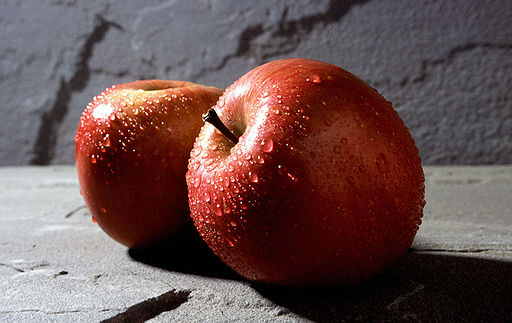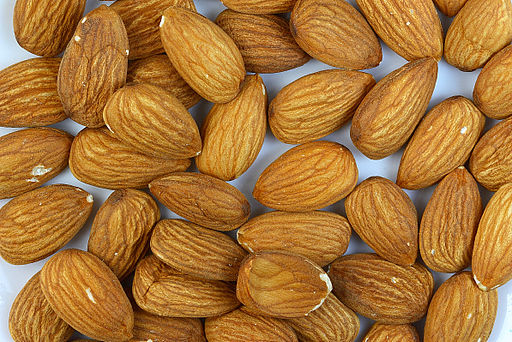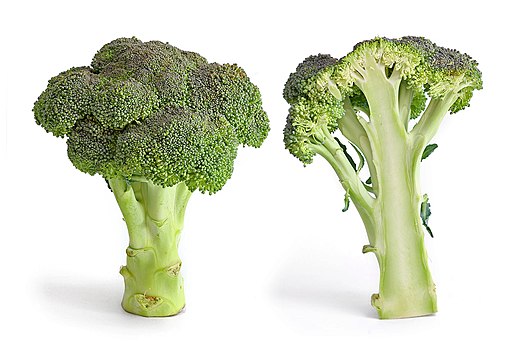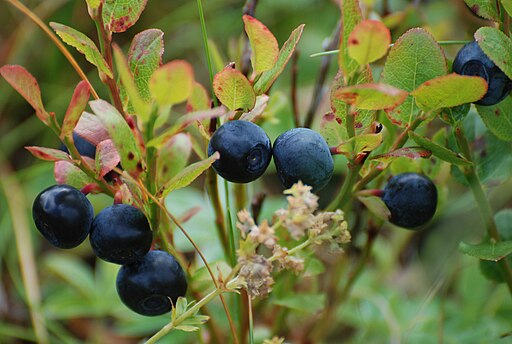Imagine a selection of foods that were delicious, nutritious and good for you - i.e. they reduced your risk of developing diseases. According to several different surveys and sources in North America and Western Europe, the following ten foods are generally considered to be the most healthy.
1) Apples
Apples are an excellent source of antioxidants, which combat free radicals, damaging substances generated in the body that cause undesirable changes and are involved in the aging process and some diseases.
Some animal studies have found that an antioxidant found in apples (polyphenols) might extend lifespans. Tests on fruit flies found that polyphenols also help them to preserve their ability to walk, climb and move about.
Another study found that adult females who regularly ate apples had a 13% to 22% lower risk of developing heart disease.

"An apple a day keeps the doctor away" is not just an old expression that rhymes
2) Almonds
Almonds are rich in nutrients, including iron,calcium, vitamin E, fiber, riboflavin, and magnesium. A scientific review published inNutrition Reviews last year found that almonds as a food may help maintain healthycholesterol levels. The authors wrote:"The message that almonds, in and of themselves, are a heart-healthy snack should be emphasized to consumers. Moreover, when almonds are incorporated into a healthy, balanced diet, the benefits are even greater."
The fatty acid profile of almonds, which is made up of 91-94% unsaturated fatty acids, may partly explain why it helps maintain healthy cholesterol levels. Almonds also have the highest fiber content of any tree nut.

Almonds have more fiber than any other tree nut
A recent article on the health benefits of almonds:
"Research Review Suggests Almonds Contain Nutrients That Provide Cardioprotective Effects"
3) Broccoli
Broccoli is rich in fiber, folate, potassium, calcium and phytonutrients. Phytonutrients are compounds which reduce the risk of developing heart disease, diabetes and somecancers. Broccoli also contains beta-carotene, an antioxidant, as well as vitamin C.
Boiling broccoli for too long can destroy much of its vital nutrients
If the enzyme myrosinase is not destroyed during cooking, broccoli can also reduce the risk of developing cancer. The best way to cook broccoli and to preserve the myrosinase is to steam the vegetable lightly - if it is overcooked, and the vegetable's beneficial effects can be seriously undermined, researchers from the University of Illinois wrote in the peer-reviewed journalNutrition and Cancer.
The researchers said that adding broccoli to a meal can often double its anticancer properties.
Another ingredient, sulforphane, which exists in broccoli, is also said to have anti-cancer as well as anti-inflammatory qualities. However, overcooking can destroy most of the benefits.
Broccoli powder does not contain myrosinase.
A recent article on the health benefits of broccoli:
"Lightly Steamed Broccoli Has Powerful Anticancer Enzyme Myrosinase"
4) Blueberries
Blueberries are rich in phytonutrients, antioxidants and fiber.According to a study carried out at Harvard Medical School, elderly people who eat plenty of blueberries (and strawberries) are less likely to suffer from cognitive decline, compared to other people of their age who do not. (Link to article)
Blueberries were found in another study carried out by scientists at Texas Woman's University, to help in curbing obesity. Plant polyphenols, which are abundant in blueberries, have been shown to reduce the development of fat cells (adipogenesis), while inducing the breakdown of lipids and fat (lipolysis). (Link to article)

Blueberries may help in controlling body weight
Regular blueberry consumption can reduce the risk of suffering from hypertension (high blood pressure) by 10%, because of the berry's bioactive compounds, anthocyanins, scientists from East Anglia University, England, and Harvard University, USA reported in the American Journal of Nutrition. (Link to article)
Blueberry consumption has also been associated with a lower risk of artery hardening, and/or intestinal diseases. The fruit has also been linked to stronger bones in animal studies.
5) Oily fish
Examples of oily fish include salmon, trout, mackerel, herring, sardines and anchovies. These types of fish have oil in their tissues and around the gut. Their lean fillets contain up to 30% oil, specifically, omega-3 fatty acids. These oils are known to provide benefits for the heart, as well as the nervous system. Oily fish are also known to provide benefits for patients with inflammatory conditions, such as arthritis.Oily fish also contain vitamins A and D.
Scientists at UCLA's Jonsson Comprehensive Cancer Center found thatprostate cancer progression was significantly slowed when patients went on a low-fat diet with fish oil supplements. (Link to article)

Oily fish are rich in omega-3 fatty acids
6) Leafy green vegetables
Studies have shown that a high intake ofdark-leafy vegetables, such as spinach or cabbage may significantly lower a person's risk of developing diabetes type 2. Researchers from Leicester University, England, said that the impact of dark green vegetables on human health should be investigated further, after they gathered data from six studies.Spinach, for example, is very rich in antioxidants, especially when uncooked, steamed or very lightly boiled. It is a good source of vitamins A, B6, C, E and K, as well as selenium, niacin, zinc, phosphorus, copper, folic acid, potassium, calcium, manganese, betaine, and iron.

Boiling spinach can significantly reduce its levels of good nutrients.
7) Sweet potatoes
Sweet potatoes are rich in dietary fiber, beta carotene, complex carbohydrates, vitamin C, vitamin B6, as well as carotene (the pink, yellow ones).The Center for Science in the Public Interest, USA, compared the nutritional value of sweet potatoes to other vegetables. The sweet potato ranked number one, when vitamins A and C, iron, calcium, protein and complex carbohydrates were considered.

Sweet potato roots are rich in fiber and several important nutrients
8) Wheat germ
Wheat germ is the part of wheat that germinates to grow into a plant - the embryo of the seed. Germ, along with bran, is commonly a by-product of the milling; when cereals are refined, the germ and bran are often milled out.Wheat germ is high in several vital nutrients, such as vitamin E, folic acid (folate), thiamin, zinc, magnesium, phosphorus, as well as fatty alcohols and essential fatty acids.
Wheat germ is also a good source of fiber.
9) Avocados
Many people avoid avocados because of its high fat content; they believe that avoiding all fats leads to better health and easier-to-control body weight - this is a myth. Approximately 75% of the calories in an avocado come from fat; mostly monosaturated fat.
Weight-for-weight, avocadoes have 35% more potassium than bananas.
Avocados are also very rich in B vitamins, as well as vitamin K and vitamin E.
Avocados also have a very high fiber content of 25% soluble and 75% insoluble fiber.
Studies have shown that regular avocado consumption lowers blood cholesterol levels.
Avocado extracts are currently being studied in the laboratory to see whether they might be useful for treating diabetes orhypertension.
Researchers from Ohio State University found that nutrients taken from avocados were able to stop oral cancer cells, and even destroy some of the pre-cancerous cells.
An article on avocados and oral cancer prevention:
"Avocados May Help Prevent Oral Cancer, OSU Study Shows")
10) Oatmeal
Oatmeal is meal made from rolled or ground oats, or porridge made from ground or rolled oats. In the United Kingdom and the Republic of Ireland, the term "porridge" or "porridge oats" are common terms for the breakfast cereal that is usually cooked.Interest in oatmeal has increased considerably over the last twenty years because of its health benefits.
Studies have shown that if you eat a bowl of oatmeal everyday your blood cholesterol levels, especially if they are too high, will drop, because of the cereal's soluble fiber content. When findings were published in the 1980s, an "oat bran craze" spread across the USA and Western Europe. The oats craze dropped off in the 1990s.
In 1997, the FDA (Food and Drug Administration) agreed that foods with high levels of rolled oats or oat bran could include data on their labels about their cardiovascular heart benefits if accompanied with a low-fat diet. This was followed by another surge in oatmeal popularity.
Oats is rich in complex carbohydrates, as well as water-soluble fiber, which slow digestion down and stabilize levels of blood-glucose.
Oatmeal porridge is very rich in B vitamins, omega-3 fatty acids, folate, and potassium.

Coarse or steel-cut oats contain more fiber than instant varieties.
Written by Christian Nordqvist
Copyright: Medical News Today